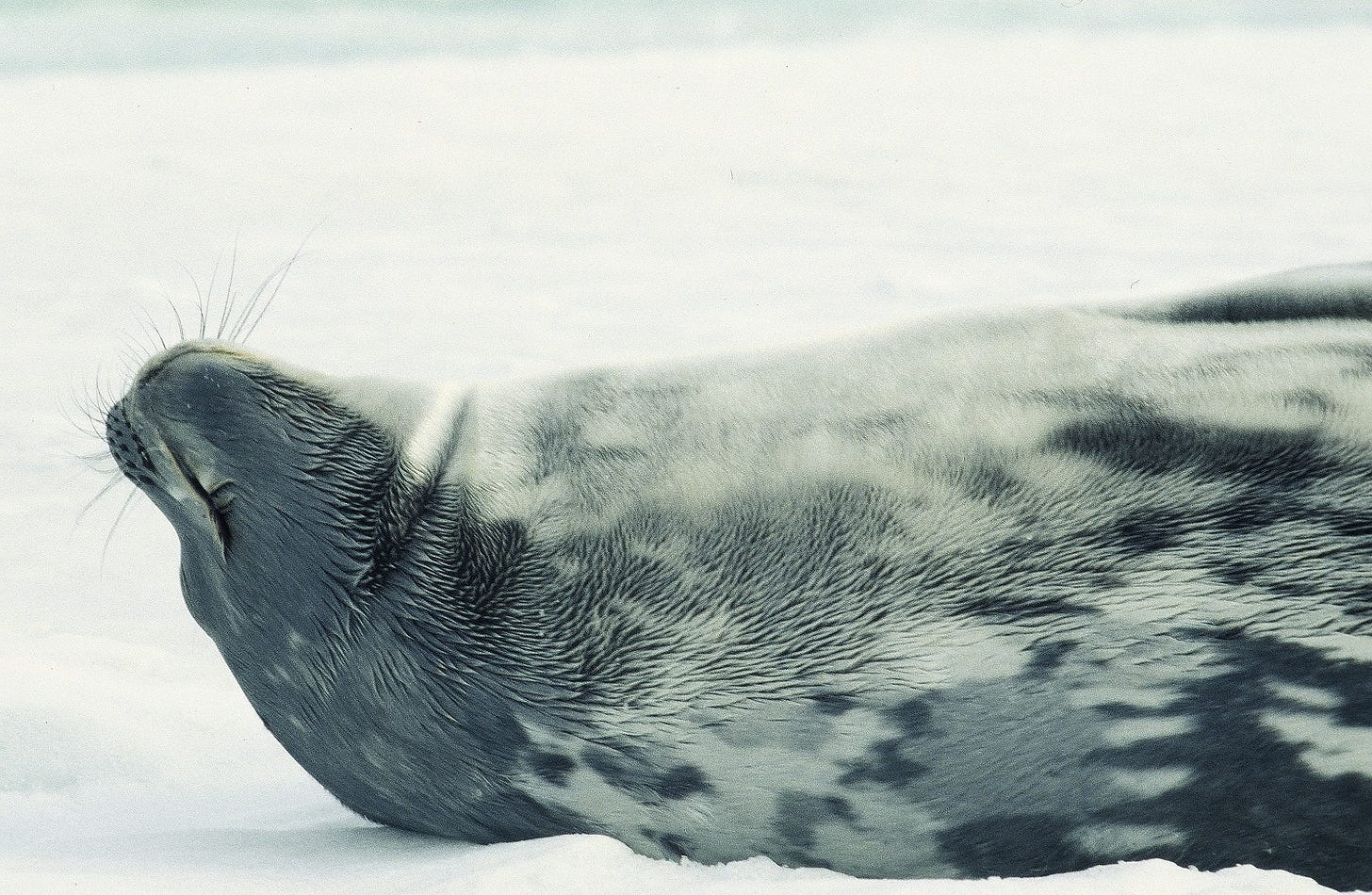Quieting the Anthropocene Seas – Part 2
2/23/23 – The necessary quest to be quieter in and on the oceans
Hello everyone:
As always, please remember to scroll past the end of the essay to read some curated Anthropocene news.
Now on to this week’s writing:
As with the ocean itself, there’s more to the topic of ocean noise than I first imagined. For that reason, my writing on it – both the noise and its solutions – will continue into next week.
Oddly enough, I first learned about bioacoustics in the quietest place on Earth: Antarctica. In the late 1990s, a researcher/composer/sound artist named Douglas Quin was in McMurdo doing some pioneering studies on the underwater soundscape in McMurdo Sound. At that point, I’d never thought about sound as an ecological phenomenon, but Quin explained that animal species who rely on sound create their own space on the audio spectrum. For their survival, they need to hear and be heard. This is particularly true in dense habitats, like a rainforest, where the cacophony of animal noise is like a crowded radio dial. Each sound-dependent bird, monkey, or insect species evolves their own radio station.
In Antarctic waters, though, there are far fewer species. Thus, the opportunities for making noise are vast. For this reason, the Weddell seal can be heard making the most extraordinary, otherworldly sounds all across the dial (and beyond – some of their noises are ultrasonic). Take a listen to a quick clip here:
For the real deal, though, here is a full two-hour immersion in Weddell seal sounds, complete with video spectrogram. I very highly recommend giving a listen to the long version. It’s beautiful and bewildering. As a reminder of how well sound travels underwater, most of the seals in this long recording were a half-mile away from the hydrophone.
If you have the right setting, consider listening to this recording as you read the rest of this essay. Keep the volume low, though; there are some loud surprises.
The acoustic environment of the oceans has evolved over at least 40 to 50 million years. The animals of the ocean, whether whale or coral, sole or grouper, alewife or anchovy, have likewise had millions of years to evolve within that environment. We’re not very good at contemplating millions of years, but take a moment to at least think about how incredibly tiny a single century is amid those millions. That century, despite its miniature status, is all it has taken us to drown out much of the ocean chorus.
It's as if that crowded radio dial with all of its marvelous diversity of music has now been overpowered by a single station playing drones and explosions for one oblivious audience.
As I noted last week, we forget that sound is an essential part of living for other species. And because we’re not underwater, we don’t hear the problem we’ve made.
To hear one very, very common version of the problem, listen to this 25-second clip from the Port of Vancouver, documenting orcas trying to communicate as a ship passes. (Check your volume before you click: the audio is loud.)
Imagine the annoying, disruptive environmental noises in our lives: construction areas, chain saws and motorcycles, heavy traffic, trains rattling by and planes roaring past. We all deal with noise, but not the way it’s experienced underwater in the noisiest places (day and night in shipping lanes), where it has been pervasive, dominant, and increasing.
Because we’re not there listening, and because we don’t really know what it means to be a sound-dependent underwater animal, we also don’t understand that in some cases our noise pollution can have population-scale impacts. In other words, we don’t know what it's like to live with noise that not only impacts individuals, but also threatens an entire species, habitat, or ecosystem. Imagine a squad of leaf-blowers haunting your neighborhood day and night, all year long, for your entire life.
A tugboat in motion is loud, producing about 170 decibels (dB). An oil tanker is even louder, at about 200 decibels. But nothing comes close to a seismic airgun at 250 dB, which can be heard underwater over an area of 115,000 square miles.
For a landlubber reference, a leaf blower is about 75 dB from fifty feet away, 100 dB if you’re running it. Thunderclaps and running chainsaws hit our ears at about 110-120 dB. If you were 25 meters away from a jet on take-off, your eardrums might be ruptured by the 150 dB it produces.
Anything below 70 dB is considered safe (if still annoying) for human ears, but remember that sound travels four to five times faster and farther underwater, and that many marine animals have more sensitive hearing than we do. (Adding insult to injury, a warming ocean transmits sound even faster.)
And the final kicker in this decibel data I’m throwing at you is that decibels are measured on a logarithmic scale, which means that the numbers I listed above are worse than you thought. Loudness doubles for every extra 10 decibels. Thus, a sound 20 dB higher than another is four times louder, and a sound 30 dB greater is eight times louder. A seismic airgun at 250 dB is 100 dB greater than a jet at take-off and thus about a thousand times louder.
Loudness in itself is not necessarily the problem. (Those of you listening to the Weddell seals won’t be surprised to know that some of their noises rival the dB of a jet engine.) The first problem of human noise underwater is that, in much of the ocean, it’s everywhere and all the time. The second problem is that much of our noise occurs on the same frequencies as those made by fish and marine mammals. And third, in the case of airguns, it is actually the incredible loudness of these devices, and the fact that they’re used so much. Here’s audio of seismic airguns from NOAA (please note the original recording was sped up for some reason):
So what can we do about our noise in the oceans? Solutions, such as they are, come in a few categories: noise avoidance (stopping the noise), noise reduction (improving technology so less noise is created), and noise-quieting (making the sound harder to hear).
Let’s take the offenders one at a time, starting with the worst.
SEISMIC AIRGUNS
The noise from seismic airguns dominates the ocean soundscape. It is essentially an echolocating technology, borrowed from marine mammals and now heedlessly weaponized against them, every ten seconds for weeks or months at a time.
As we all know, the best thing for all life on Earth is for us to stop searching for fossil fuels and leave most of those carbon-rich substances in the ground. The faster we wean ourselves off fossil fuels the faster seismic airguns will become obsolete.
To get there, we need to continue making policy that 1) accelerates the energy transition, 2) reduces energy consumption and plastic production, and 3) makes the offshore search for fossil fuels harder to permit. The first two are beyond the scope of this essay, but I can at least point to the rapid rise of renewables in both the U.S. and in Europe. We are much better, though, at reimagining consumption than reducing it.
There has never been a better time to push for strict regulation of airgun use. Climate activists are pushing hard to keep the energy companies and banks from investing in any new oil or gas exploration. Since seismic airguns exist mostly to search out new fossil fuel deposits below the sea floor, restricting their use could be a useful leverage point.
Policy to limit or prohibit seismic airgun use is not new, but so far has had minimal effect. U.S. Congressional legislation to ban their use has been written but not passed. The Obama administration denied permits for oil exploration in waters off the U.S. east coast, and when the Trump administration rolled back that prohibition, lawsuits from environmental groups and several states led to a stalemate in which the permits for exploration expired. Given the rise of renewables, including offshore wind, that success seems likely to hold. Elsewhere, limits on airgun use from Canadian and European authorities exist, though with limited effectiveness.
Until energy policy and market-driven solutions make airguns obsolete, a better technology is required. The answer there seems to be marine vibroseis, which “uses a diaphragm-like device to release the same amount of energy as an air gun but spread over a longer wavelength—the result is a deep hum, rather than a crash.” These machines “gently” vibrate the seabed rather than violently disturbing the entire water column, producing more of a hum than a bang. An article in Hakai explains how the inventor of seismic airguns developed marine vibroseis as a solution to the problem he created.
But the technology is still unproven, in part because it has been underfunded and understudied. The fossil fuel industry has little motivation to change what works, since they have the power to shape economies, control legislation, and generally act with impunity. Because of the lack of study, it is also still unclear what the environmental cost will be to the seabed from extensive use of marine vibroseis. There is the possibility, for example, that while it reduces some harms it may increase masking of some fish or mammal communications.
MILITARY EXPLOSIONS
Only military explosions, mainly from training and testing exercises, shake up the ocean soundscape as much as seismic airguns. To give one example, a 2018 press release from the Center for Biological Diversity noted that permits issued to the Navy for a five-year period (through 2023) would “harm marine mammals 12.5 million times” in waters off California and Hawaii. This includes damage from sonar and ship strikes too.
There are other sources of explosions, as in construction or dismantling of oil rigs, but I’ll address those in a later section.
Occasionally the Navy uses major explosions to shock-test ships, which can kill or damage fish, invertebrates, and marine mammals that are miles away. And as I detailed last week, Russia’s unprovoked war in Ukraine – with extreme noise levels from explosions and sonar – has been absolutely devastating for dolphins and other marine animals.
Because of the scale and institutional nature of the powers at work here, again we’re dependent on good policy to put protections in place. The good news is that constant vigilance (and lawsuits) from environmentalists and conservation-minded politicians has prompted the Navy to include marine mammal safety in their planning. The shock-test I mentioned above, for example, included extensive planning and surveying (before, during, and after) by a team of observers, researchers, and veterinarians. And a recent permit from the National Marine Fisheries Service for the Navy in the waters off the U.S. northwest requires some additional protective measures.
That said, these measures are merely softening the brutal status quo rather than reducing the large-scale harm. Those observers are watching for whales and dolphins within a kilometer or so of the ship, though the explosion was audible for thousands of miles.
Short of reducing naval activity or convincing the Navy to do their training and testing via computer simulation, there’s not much else to be done other than continuing to push for greater restrictions.

Next week I’ll explore the harms and solutions related to sonar, shipping noise (propellers especially), wind farms, private boats, and more. Stay tuned to this topic, especially if you own a boat. I’ll dig into options for quieting your own presence on the water.
For now, remember that like the songs of Weddell seals, our presence on the planet can be strange – even bizarre – without being so harmful.
Thanks for sticking with me.
In other Anthropocene news:
From E&E News Greenwire, state and federal funding for wildlife crossings in the U.S. is at an all-time high. This is excellent news. For more on wildlife crossings, you can dive into my three-part series which starts with Road Ecology. The terrible truth is that our transportation networks make up “the most extensive form of impact humans have on natural systems.”
From the Revelator, the problem of biophobia, the fear and disgust some people feel toward nature because they have not experienced it. The great E.O. Wilson coined the term “biophilia” many years ago to describe our innate fascination with nature, but generation by generation we’ve become less connected and more unnerved. The solution is simple: get your kids and grandkids outside, and go with them, taking a deep breath and looking for joy and wonder. To read more, check out this new report from the Guardian on the now well-documented health benefits of spending time outdoors.
Public power and gas utilities are using our ratepayer money to fund efforts to slow the clear energy transition. This should be illegal. To learn more, listen to David Roberts’ latest Volts podcast and read the report from the Energy and Policy Institute. Roberts puts the problem nicely in his podcast intro: “They have effectively conscripted their customers, who have no choice where to get their power and gas, into an involuntary small-donor army working against the public interest.”
Two interesting-looking books I haven’t read: From The American Prospect, a review of The Great Displacement: Climate Change and the Next American Migration, by Jake Bittle. It seems like a well-written and sobering book, and a crucial reminder that a geographic upheaval is already beginning. You can see Bittle’s Guardian article on the topic here. And from Inside Climate News, a review of Profit: An Environmental History, by Mark Stoll, a thorough history of the human manipulation of the environment and its consequences, most notably the advent of modern capitalism and its rapid destruction of planetary ecology.
From Grist, the staffing problem at the EPA, which was gutted under the previous administration but now needs to be reinvigorated and enlarged in order to meet its expanded mission.
From the Washington Post, a close look at the heat pump revolution in Maine and the frantic disinformation campaign by the fossil fuel industry to slow it down. And for those of you curious about the magical heat pump technology, read this excellent explainer from the MIT Technology Review.
From Bill McKibben at his always-useful The Crucial Years newsletter, the ouster of a climate-denier at the head of the World Bank and the absolute necessity to replace him with an economist who will turn the institution into essential financial infrastructure for financing the clean energy revolution at affordable rates in poorer countries.
From Wired, the dirty secret of the new AI systems that will soon dominate internet life will come with extraordinary increases in electricity needs. Unsurprisingly, that means that artificial life will have increased consequences for natural life.






This is a tremendously informative series. I had no idea of the science of bioacoustics or of things like the airgun and the disruption they cause. Lots of thanks.
Another fascinating and encouraging pice. I'm looking forward to next week. The seal song is incredible.